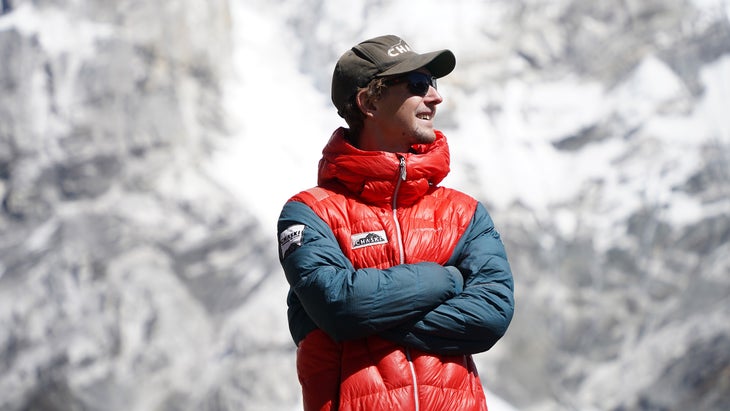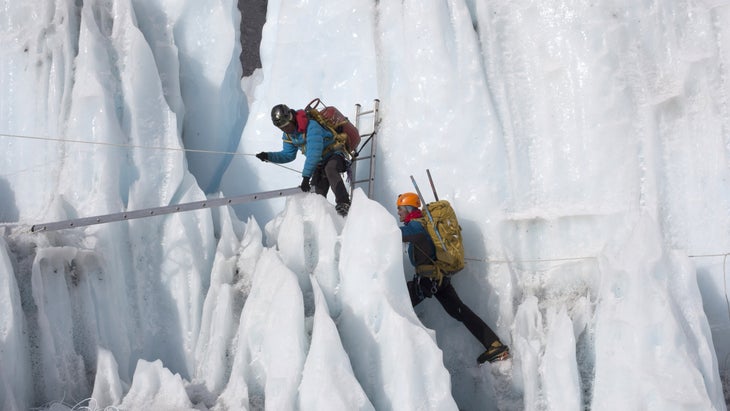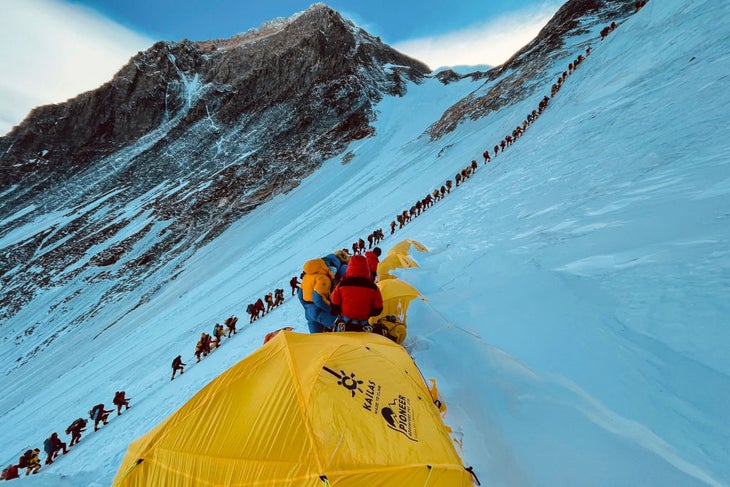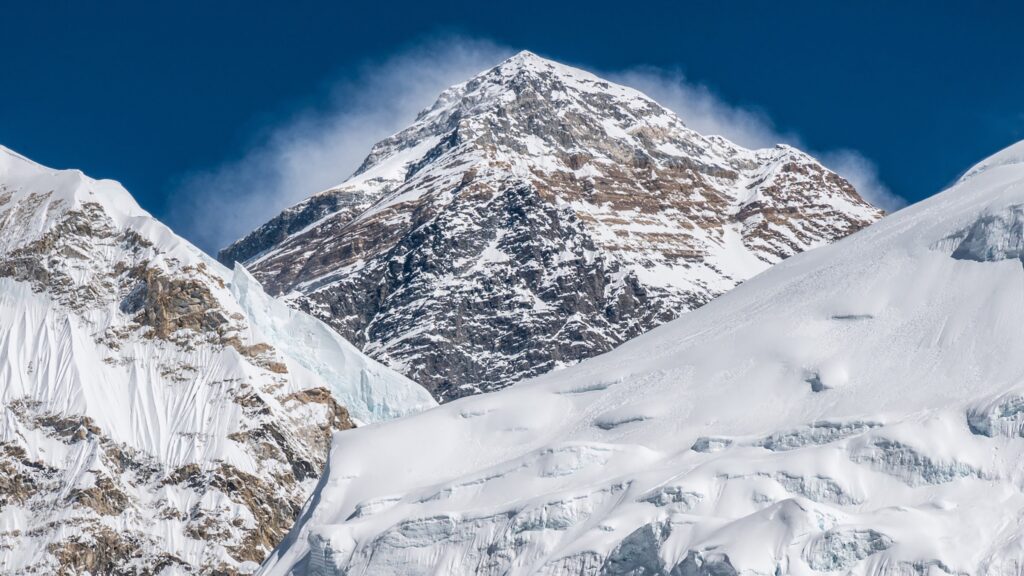After striking out five times on the world’s highest peak, an American ultrarunner is questioning the feasibility of breaking the fastest known time from Nepal
More than 100 climbers reached the Everest summit on Wednesday. (Photo: Boy_Anupong/Getty Images)
Published October 8, 2025 12:07PM
In the dark of night on Monday, September 22, American ultrarunner Tyler Andrews was making his way through the Khumbu Icefall, the massive glacier at the base of Mount Everest, when disaster struck. While navigating a fragile bridge across a massive crevasse, the snow beneath his feet gave way, and he plummeted into the hole.
Andrews, 35, was only wearing a t-shirt at the time, his minimalist attire due to his attempt at setting the speed record for ascending the world’s highest peak from Nepal without the use of supplemental oxygen. His fall was stopped by the safety rope affixed to his harness, leaving him dangling below an overhanging wall in darkness.
“That was really, really f-ing scary,” Andrews told Outside. “I had to use a bunch of different skills in that situation, including just the ability to stay calm in a crisis in the mountains, in the middle of the night at 6,000 meters elevation, which is not trivial.”
Andrews eventually freed himself from the pit and got back on the trail, but the fall marked an ominous bellwether for his expedition. Hours later, he turned back short of the summit when he encountered deep snowdrifts on the peak’s upper flanks.

Andrews made a second attempt on September 25, climbing past Camp IV and onto the highest section of the route. But the deep snow slowed him, and he again turned back, and headed to Base Camp, where he eventually decided to call it quits.
Andrews spoke to Outside while he was on a beach in Thailand, recovering from the two ascents.
“I’m really, really tired,” Andrews added. “I’m still getting sensation back in a couple of my toes.”
These marked his fourth and fifth unsuccessful attempts in 2025 at breaking the speed record on the world’s highest peak without the use of supplemental oxygen. The current record, set by Nepali climber Kaji Sherpa in 1998, stands at 20 hours, 24 minutes.
“It’s very hard for me to look at stuff from other people’s point of view and see that it’s pretty remarkable,” Andrews said. “For me, it’s like I’ve gone out, taken a swing, and I’m zero for five. And that sucks.”
The Hurdles of Record Chasing at Extreme Altitude
When Andrews first arrived at Mount Everest Base Camp in May, he expected a completely different outcome. After months of high-altitude training, he was in the best shape of his life, he told Outside, and the conditions on the mountain looked ideal.
“There’s literally no part of me that thought I would leave Nepal in the spring without the record,” he added, “I just couldn’t imagine a scenario where I wouldn’t be able to get it done in two tries.”
His first attempt on May 10 was his closest shot at the record. He departed Base Camp in the middle of the night, speeding through the Khumbu Icefall and up through the Western Cwm well ahead of record pace. But at Camp III, as Andrews changed from lightweight footwear into his mountaineering boots, the zipper on one of his boots broke. He tried to fix the damage, but to no avail, and after snow and ice began to seep into his sock, he turned back.
“I think it would have gone that day if my boot didn’t break,” he said. “The frustrating thing about that is that it was the first attempt, and then all this other part of the story would never have happened. You only really need one little thing to go wrong.”
On his second attempt, Andrews was forced to turn back from the summit by violent winds. He regrouped and made a third attempt, but turned back due to exhaustion.
Andrews abandoned his spring attempt and, after recovering from his efforts, returned to training, determined to come back even stronger for the quieter fall season. His optimism was buoyed by the fact that both the current record and the one before it, set by French alpinist Marc Batard and Kaji Sherpa, respectively, were achieved in the fall. When he arrived at Base Camp in September, Andrews felt that he was the strongest he’d ever been.

In the spring, Andrews was accompanied by a large documentary film crew and a full support team. For the fall, he pared his expedition down to a small group, hoping that fewer crew would mean fewer chances for things to go wrong.
“There were times that almost felt like there were just too many people trying to get too much done,” he said. “Everything that I’ve done in the past that has gone really, really well has been with a very small team. And I think especially on a mountain like Everest, that’s so complex, that’s still the best way. The simpler it is, the better, because there’s just fewer points of failure.”
But he still encountered problems. During his September 25 attempt, barely recovered from his fall in the Khumbu Icefall, Andrews charged up the Lhotse face. Because of an unstable snowpack, he followed fixed lines on a steeper route to the left that led directly to the South Col.
“The Lhotse Face was, if anything, better than I expected. The lower part had decent snow, and I was moving a little bit better, a tiny bit ahead of what I predicted, which was great,” he said. “And then, somewhere near the top, maybe around 7,800 meters (25,590 feet), the snow started to get real, real bad.”
Andrews had planned to follow two strong Sherpas from Camp IV to the summit, conserving his strength for the final push. When he arrived, he met them returning to camp, having abandoned their attempt because the snow was too deep and unstable.
“They basically told me it’s not possible,” Andrews said. “They were just like, ‘It’s not going to happen, man.’ So I tried to go out of camp and walk up a little bit, and even following in their footsteps was quite slow.”
He tried to persuade the Sherpas to spend the night and attempt the summit the next morning—he wouldn’t get the record, but he would complete a rare no-oxygen ascent. The Sherpas refused, citing insufficient oxygen supplies as a concern for their own safety.
“It was a team decision,” he explained. “I recognize I could have gone solo, and if I were an elite mountaineer, maybe I would have done that. But I’ve always said, you know, I’m not an elite mountaineer. I’m not an alpinist, and that’s not my skillset. So we sat in the camp for a bit and then made the very, very long trip all the way back to Base Camp.”
Is the FKT on Everest Even Possible?
Mount Everest presents major hurdles to speed climbers like Andrews. The high winds and bad weather only subside for a handful of weeks in the spring, and that’s when dozens of commercially guided expeditions attempt to scale the peak. These expeditions wait for the best windows of calm weather to push for the summit, and their ascents are usually slowed by bottlenecks and congestion.
Andrews had to schedule his spring ascents so as to not overlap with the commercial climbs, and that meant targeting days with questionable weather or poor conditions along the route.
That wasn’t the case in 1998 when Kaji Sherpa made his record-breaking ascent. Only about 100 people climbed Mount Everest that year. By contrast, around 700 people reached the summit from Nepal in 2025.

There are far fewer climbers on Mount Everest in the fall than in the spring, but the peak’s higher flanks are often buried under deep snowfall after the summer monsoons. And the route to the summit is often swept over by avalanches.
Given the intense commercialization and crowding on Mount Everest in the spring, and the increasingly unstable fall weather driven by climate change, even Andrews wonders if the Mount Everest speed record is attainable.
“Even after the first attempt, I was just like, ‘maybe this record is just not possible from Nepal anymore,” Andrews told Outside. “I definitely did think the conditions were going to be better. And, you know, maybe that was just naiveté on my part.”
Andrews told Outside that he has no plans yet to return to Mount Everest in 2025 or next year. He will take a few weeks to rest and recover before deciding on whether or not he will continue to chase the record.
But Andrews has already drawn considerable attention to the peak and the attempts to climb it as quickly as possible. Prior to Mount Everest, he set speed records on 26,781-foot Manaslu, 22,837-foot Aconcagua, as well as Mount Fuji, Kilimanjaro, and other high peaks.
“The thing that I’m the most proud of is that I’ve been able to grow a lot as a mountain athlete in terms of my ability to handle crises and make decisions,” Andrews said. “I think I’m more proud of the process than the outcome.”


